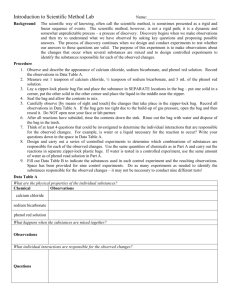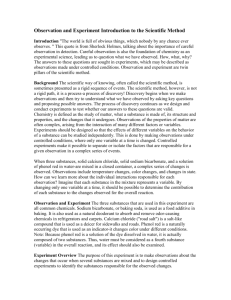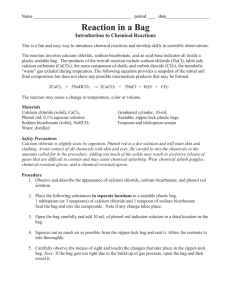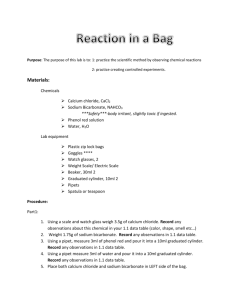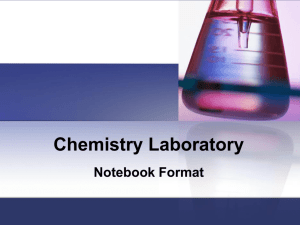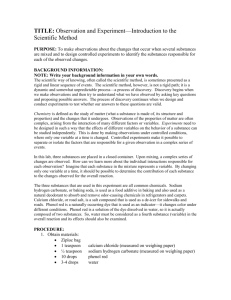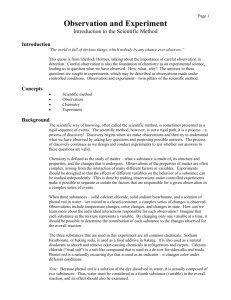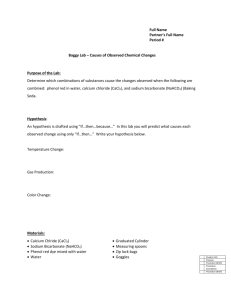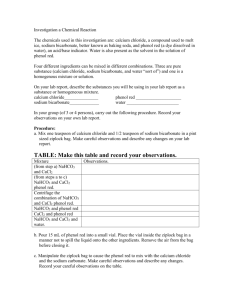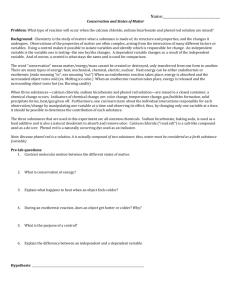Observation Of A Chemicl Reaction
advertisement
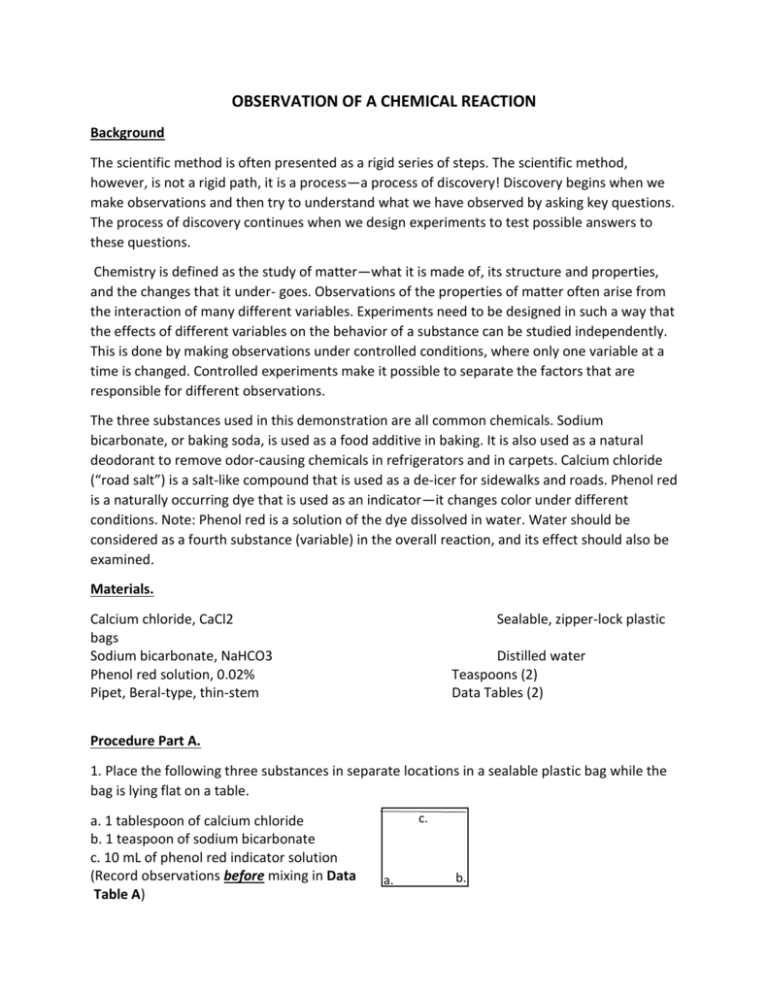
OBSERVATION OF A CHEMICAL REACTION Background The scientific method is often presented as a rigid series of steps. The scientific method, however, is not a rigid path, it is a process—a process of discovery! Discovery begins when we make observations and then try to understand what we have observed by asking key questions. The process of discovery continues when we design experiments to test possible answers to these questions. Chemistry is defined as the study of matter—what it is made of, its structure and properties, and the changes that it under- goes. Observations of the properties of matter often arise from the interaction of many different variables. Experiments need to be designed in such a way that the effects of different variables on the behavior of a substance can be studied independently. This is done by making observations under controlled conditions, where only one variable at a time is changed. Controlled experiments make it possible to separate the factors that are responsible for different observations. The three substances used in this demonstration are all common chemicals. Sodium bicarbonate, or baking soda, is used as a food additive in baking. It is also used as a natural deodorant to remove odor-causing chemicals in refrigerators and in carpets. Calcium chloride (“road salt”) is a salt-like compound that is used as a de-icer for sidewalks and roads. Phenol red is a naturally occurring dye that is used as an indicator—it changes color under different conditions. Note: Phenol red is a solution of the dye dissolved in water. Water should be considered as a fourth substance (variable) in the overall reaction, and its effect should also be examined. Materials. Calcium chloride, CaCl2 bags Sodium bicarbonate, NaHCO3 Phenol red solution, 0.02% Pipet, Beral-type, thin-stem Sealable, zipper-lock plastic Distilled water Teaspoons (2) Data Tables (2) Procedure Part A. 1. Place the following three substances in separate locations in a sealable plastic bag while the bag is lying flat on a table. a. 1 tablespoon of calcium chloride b. 1 teaspoon of sodium bicarbonate c. 10 mL of phenol red indicator solution (Record observations before mixing in Data Table A) c. c. . a. b. 2. Squeeze out as much air as possible from the zipper-lock bag and seal it. 3. Allow the contents to mix thoroughly. 4. Record all their observations in Data Table A. (Note: If the bag gets too tight due to the buildup of gas pressure, open the bag and then reseal it. Do NOT open the bag near your face or the face of any student!) 5. The contents of the bag can be rinsed down the drain under running water. Rinse out the bag with water and dispose of the bag in the trash. 6. Discuss your observations with your group. What questions arise concerning the changes that were observed during the reaction in the bag? Write at least four questions that could be investigated to determine the individual interactions that are responsible for the observed changes. For example, is water or a liquid necessary for the reaction to occur? Write your questions down in the spaces provided in Data Table A. Data Table A. The Overall Reaction What are properties of the individual substances? Observations Chemical Calcium Chloride Sodium Bicarbonate Phenol Red What happens when the substances are mixed together? Observations What interactions are responsible for the observed changes? Questions For Part B, your team will complete only 3 out of the following 9 trials in an effort to determine which chemical is responsible for each of the observations from part A. Data Table B. Control Experiments Trial Number 1 2 3 4 5 6 7 8 9 Calcium Chloride Sodium Bicarbonate Phenol Water Red Observations Post-Lab Questions: Copy the questions and provide space on your paper to answer each question. 1. Was there a temperature effect observed in any of the individual control experiments that was NOT observed in the overall reaction of the four chemical substances? Explain. 2. What color change was observed in the overall reaction of the substances? Do the control experiments provide any evidence concerning the interaction(s) responsible for the observed color change? 3. Does the formation of gas bubbles occur independently of the observed temperature and color changes? Explain. 4. What control experiments were done to evaluate if a liquid is necessary for the observed effects in Part A? Does any reaction occur in the absence of water? 5. Is there any evidence that a new chemical substance is produced in the overall reaction of the four substances mixed in Part A? Explain.

